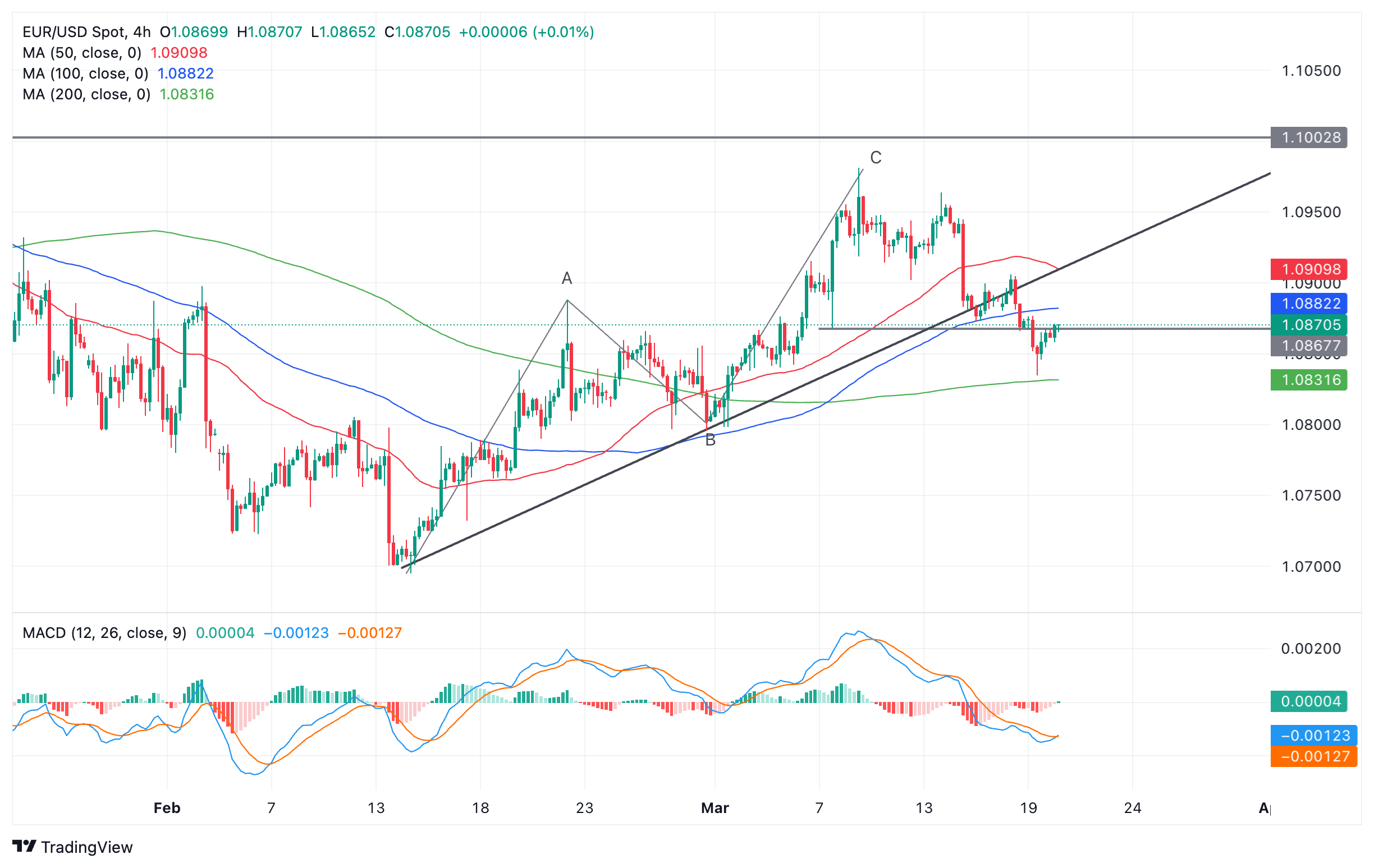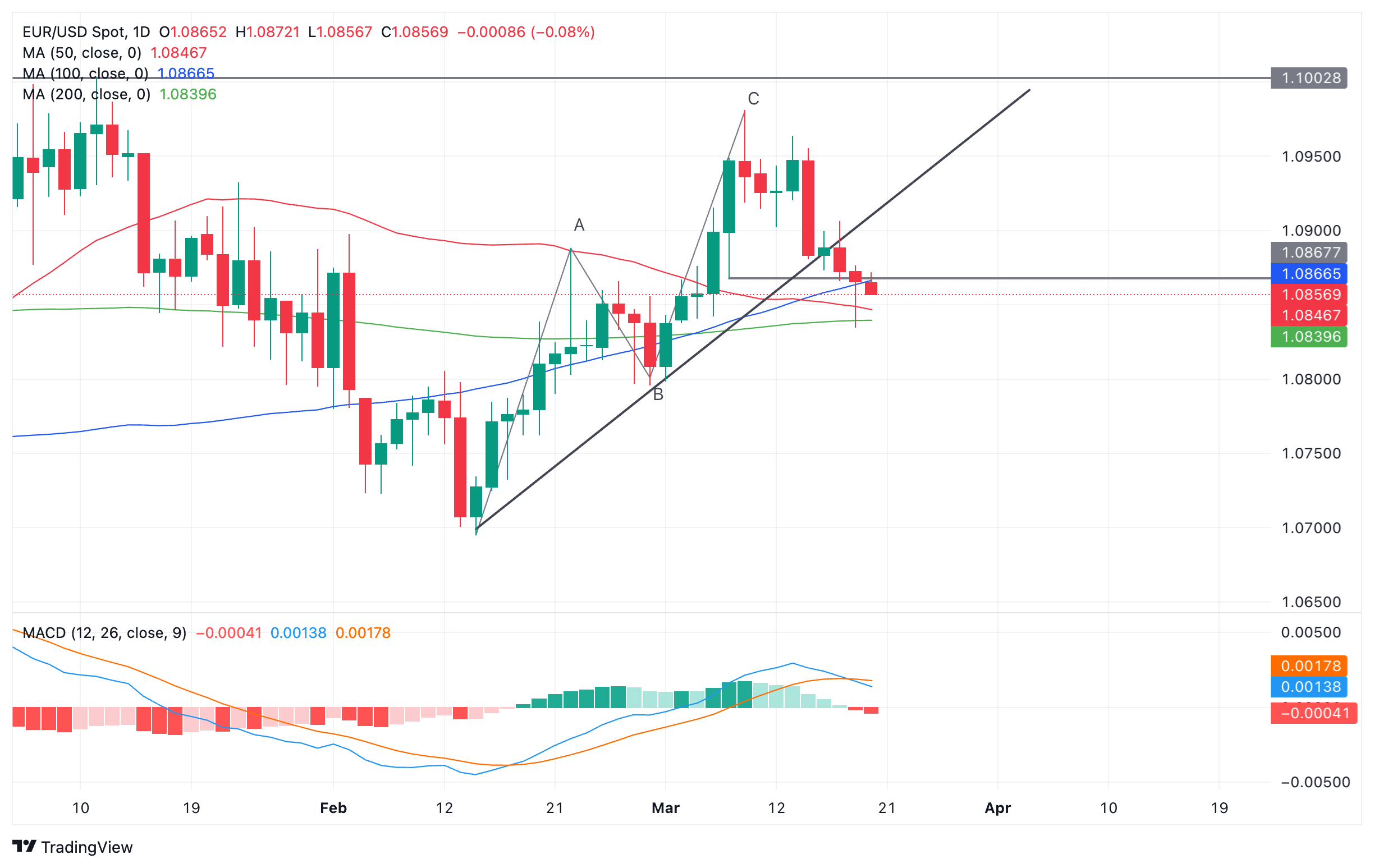EUR/USD weakens after Lagarde comments, ahead of Fed meeting

- EUR/USD declines back to lower 1.0800s ahead of Wednesday’s Fed meeting.
- Speculation is mounting that the Fed could alter how many interest rate cuts it expects to make in 2024.
- Lagarde mentions falling wage inflation, a key metric for the ECB.
EUR/USD declines back to the lower 1.0800s on Wednesday, after several European Central Bank (ECB) speakers, including the President of the ECB Christine Lagarde and the Bank of Ireland Governor and ECB governing council member Gabriel Markhlouf cite lower inflation.
ECB’s Lagarde highlighted lower wage inflation, something which at previous meetings she said the ECB would be watching closely before deciding future ECB policy moves.
“Average wage growth in 2024 for all existing wage contracts fell from 4.4% at the time of our January Governing Council meeting to 4.2% at the time of our meeting in March,” said Lagarde at the ECB and its Watchers” conference on Wednesday.
Lower inflation increase the probability that the ECB will opt to cut interest rates which would be a negative move for the Euro (EUR) and the EUR/USD pair.
Interest rates, set by central banks, are a key driver of foreign exchange markets. Lower interest rates tend to depreciate a currency by attracting less foreign capital inflows and vice versa for higher interest rates.
EUR/USD could be impacted if Fed changes forecasts
The Federal Reserve is scheduled to complete its March policy meeting at 18:00 GMT on Wednesday and while it is not expected to alter interest rates there is a chance it could revise its quarterly forecasts and accompanying statement. This could change the outlook for interest rates and therefore the US Dollar (USD) valuation.
EUR/USD could see volatility as speculation is mounting that the Federal Reserve will revise its economic forecasts in the Summary of Economic Projections (SEP), and the “dot plot”, which reflects the Board of Governors of the Fed’s consensus of the future path of rates.
In the previous SEP, officials forecast three 25 basis points (0.25%) rate cuts in 2024 but some analysts now think there is a material risk that this could be revised down to two 25 bps cuts to reflect inflationary pressures remaining elevated.
“The summary of economic projections will be updated and contains hawkish risks in our assessment with the committee potentially projecting fewer cuts in 2024,” says David Doyle, head of economics at Macquarie, in a note about the Fed meeting.
ECB speakers take the stand
In Europe, a similar debate is going on about when to begin cutting interest rates, with two camps emerging – those who favor waiting until the European Central Bank’s June meeting to decide (the official camp) and a smaller mutineering group who want to keep alive the possibility of an early spring rate cut.
On Tuesday, Vice-President of the European Central Bank (ECB), Luis de Guindos, maintained allegiance with the June camp after he said “we have to wait,” because “services inflation” remains too high.
Wednesday sees a host of ECB talking heads appear in public who could provide further intelligence on which way the ECB is swinging. This may also impact EUR/USD volatility.
The ECB President Christine Lagarde, ECB Chief Economist Philip Lane and ECB’s Gabriel Markhlouf have all already spoken at the “ECB and its Watchers” conference. ECB Executive Board member Isabel Schnabel is also set to speak at 13:45 GMT.
Later, the President of the Bundesbank, Joachim Nagel, is scheduled to take the podium at a “Future of European Finance” conference at the ASKO Europa-Stiftung Foundation.
Technical Analysis: EUR/USD falls below key level
EUR/USD has penetrated below the level of the 1.0867 swing lows and in doing so probably reversed the direction of the short-term uptrend. Now the odds slightly favor more losses.
Euro versus US Dollar: 4-hour chart
Subject to fundamentals, the price will probably continue to fall to the next key support level at roughly 1.0800 – the lows of wave B of the Measured Move that unfolded in February and early March.
Tuesday’s sell-off fell to a low of 1.0835 before recovering and thereby forming a bullish Japanese hammer reversal candlestick pattern on the 4-hour chart. This was followed by a little move higher. Since candlesticks are only short-term patterns, this upside could be at risk of petering out.
The daily chart below is showing the Moving Average Convergence/ Divergence (MACD) momentum indicator crossing over the signal line, giving a bearish sell signal, and adding further evidence to a change of trend.
However, it is also flagging up some key barriers to progress lower in the form of dynamic support from the red 50-day and then the green 200-day Simple Moving Averages (SMA).
Euro versus US Dollar: Daily chart
On Tuesday price penetrated the 50-day SMA situated at 1.0848 but was repulsed by the 200-day SMA at 1.0839. As on the 4-hour chart, the price recovered and formed a hammer candlestick on the daily chart as well.
For confirmation of the hammer’s bullish reversal potential, Wednesday needs to end on a bullish note as a green candlestick. If that is the case, EUR/USD is likely to continue its recovery higher.
(This story was corrected on March 20 at 12:40 GMT to say ‘Tuesday’s sell-off to a low of 1.0835’ rather than Thursday’s sell-off.)
ECB FAQs
The European Central Bank (ECB) in Frankfurt, Germany, is the reserve bank for the Eurozone. The ECB sets interest rates and manages monetary policy for the region. The ECB primary mandate is to maintain price stability, which means keeping inflation at around 2%. Its primary tool for achieving this is by raising or lowering interest rates. Relatively high interest rates will usually result in a stronger Euro and vice versa. The ECB Governing Council makes monetary policy decisions at meetings held eight times a year. Decisions are made by heads of the Eurozone national banks and six permanent members, including the President of the ECB, Christine Lagarde.
In extreme situations, the European Central Bank can enact a policy tool called Quantitative Easing. QE is the process by which the ECB prints Euros and uses them to buy assets – usually government or corporate bonds – from banks and other financial institutions. QE usually results in a weaker Euro. QE is a last resort when simply lowering interest rates is unlikely to achieve the objective of price stability. The ECB used it during the Great Financial Crisis in 2009-11, in 2015 when inflation remained stubbornly low, as well as during the covid pandemic.
Quantitative tightening (QT) is the reverse of QE. It is undertaken after QE when an economic recovery is underway and inflation starts rising. Whilst in QE the European Central Bank (ECB) purchases government and corporate bonds from financial institutions to provide them with liquidity, in QT the ECB stops buying more bonds, and stops reinvesting the principal maturing on the bonds it already holds. It is usually positive (or bullish) for the Euro.

